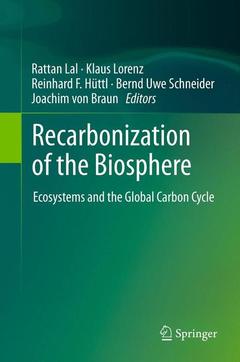Description
Recarbonization of the Biosphere, 2012
Ecosystems and the Global Carbon Cycle
Coordinators: Lal Rattan, Lorenz Klaus, Hüttl Reinhard F., Schneider Bernd Uwe, von Braun Joachim
Language: English
Subjects for Recarbonization of the Biosphere:
560 p. · 15.5x23.5 cm · Paperback
Description
/li>Contents
/li>Comment
/li>
Foreword (K. Töpfer, R. Hill)
1. Terrestrial Biosphere as a Source and Sink of Atmospheric Carbon Dioxide (R. Lal, K. Lorenz, R. F. J. Hüttl, B. U. Schneider, J. von Braun)
2. Climate Change Mitigation by Managing the Terrestrial Biosphere (R. Lal)
3. Atmospheric Chemistry and Climate in the Anthropocene (P. J. Crutzen, K. Lorenz, R. Lal, K. Töpfer)
4. Historic Changes in Terrestrial Carbon Storage (R. A. Houghton)
5. Soil Erosion and Soil Organic Carbon Storage on the Chinese Loess Plateau (C. Dahlke, H. R. Bork)
6. Methane Emissions from China’s Natural Wetlands: Measurements, Temporal Variance and Influencing Factors (X. Wang, F. Lu, L. Yang)
7. Accounting more precisely for peat and other soil carbon resources (Hermann F. Jungkunst, Jan Paul Krüger, Felix Heitkamp, Stefan Erasmi, Stephan Glatzel Sabine Fiedler, and Rattan Lal)
8. Permafrost - Physical Aspects, Carbon Cycling, Databases and Uncertainties (J. Boike, M. Langer, H. Lantuit, S. Muster, T. Sachs, P. Overduin, S. Westermann, D. McGuire)
9. Carbon Sequestration in Temperate Forests (R. Lal, K. Lorenz)
10. Decarbonization of the Atmosphere: Role of the Boreal Forest under Changing Climate (J. S. Bhatti, R. Jassal)
11. Recarbonization of the Humid Tropics (M. Venter, O. Venter, S. Laurance, M. F. Bird)
12. Carbon Cycling in the Amazon (C. C. Cerri, M. Bernoux, B. J. Feigl, C. E. P. Cerri)
13. Grassland Soil Carbon Stocks: Status, Opportunities, Vulnerability (R. T. Conant)
14. Cropland Soil Carbon Dynamics (K. Lorenz, R. Lal)
15. The Carbon Cycle in Drylands (P. Serrano-Ortiz, E. P. Sánchez-Cañete, C. Oyonarte)
16. Carbonization of Urban Areas (G. Churkina)
17. Potential Carbon Emission Trajectories of Shanghai, China from 2007 to 2050 (R. Guo, X. Cao, J. Zhang, F. Li, H. Wang)
18. Processes of Soil Carbon Dynamics and Ecosystem Carbon Cycling in a Changing World (F. Heitkamp, A. Jacobs, H. F. Jungkunst, S. Heinze, M. Wendland, Y. Kuzyakov)
19. Terrestrial Carbon Management in Urban Ecosystems and Water (K. Butterbach-Bahl, M. Dannenmann)
20. Carbon Storage and Sequestration in Subsoil Horizons: Knowledge, Gaps and Potentials (C. Rumpel, A. Chabbi, B. Marschner)
21. Transforming Carbon Dioxide from a Liability into an Asset (C. Rubbia)
22. Bioenergy and Biospheric Carbon (T. Beringer, W. Lucht)
23. The Economics of Land and Soil Degradation – Toward an Assessment of the Costs of Inaction (J. v. Braun, N. Gerber)
24. Assessment of Carbon Sequestration Potential in Coastal Wetlands (J. T. Morris, J. Edwards, S. Crooks, E. Reyes)
25. Research and Development Priorities Towards Recarbonization of the Biosphere (R. Lal, K. Lorenz, R. F. J. Hüttl, B. U. Schneider, J. von Braun)
Nobel laureates and renowned experts deliberate on the possibilities of managing the Earth-Human System for slowing-down atmospheric increases in carbon dioxide and for recarbonization of the biosphere
The comparison of ecosystems and their role in the global carbon helps the reader in identifying challenges and opportunities to prioritize C sinks for managing recarbonization
Includes interdisciplinary and transdisciplinary approaches for redistribution of C among biospheric C pools




